Don’t Treat All Decisions the Same
Summary Insight:
If you want speed, accountability, and execution at scale, stop drowning in policies. Start operating from principles that cut noise, clarify decisions, and unleash momentum.
Key Takeaways:
- Not all decisions are created equal—Type 1 and Type 2 require different playbooks.
- The 3 Agreements build a culture of ownership, alignment, and fast execution.
- Principles without consequences are platitudes. Enforce what you say matters.
If I were to ask you — “How are you instilling a culture of speed, accountability, and teamwork as your organization scales up?” — how would you respond?
This is a critical question. On the one hand, you want to keep what works well from your early start-up culture — fast decision making, risk-taking, camaraderie, and innovation. On the other, you have to manage the growing complexity — more people, new product lines, multiple business units, increasing regulatory requirements, and more. How can you achieve both?
Most entrepreneurs and CEOs struggle with this. They know that as their business scales up, they must evolve how the business operates, makes decisions, and cascades its culture. They also rightly fear that more policies, centralization, and procedures could cause the company to bog down and lose its entrepreneurial edge. The status quo is no longer tenable. You need a cure but the cure shouldn’t also kill the patient. What to do?
If we were to ask Jeff Bezos the same question — How do you instill a culture of speed, accountability, and teamwork at Amazon?” — he’d say something like this:
“Amazon’s management philosophy is to be customer obsessed, treat every day as if it were Day 1, manage the two major types of decisions (Type 1 and Type 2) differently, reinforce that it’s better to disagree and commit than get stuck in information paralysis, and elevate true misalignment issues quickly.”
What Bezos has figured out, and what he’s consistently trying to communicate and reinforce, is that to be effective at scale means to build on principles, not on policies. Policies, procedures, and rules may be necessary to some extent (especially if you are in a highly regulated industry) but they do not create high performance. As you know, they often prevent high performance.
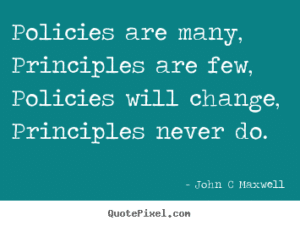 Principles, on the other hand, are designed to be few in number but strong in impact. Meaning, a principle points you in the right direction but calls on the common sense and creativity of the individuals executing it. Also, if a principle is violated, this must carry big consequences. It has to, or it has no weight; it’s just a platitude.
Principles, on the other hand, are designed to be few in number but strong in impact. Meaning, a principle points you in the right direction but calls on the common sense and creativity of the individuals executing it. Also, if a principle is violated, this must carry big consequences. It has to, or it has no weight; it’s just a platitude.
If you’re like me and you tend to resonate with the principles-over-policies approach to scaling a business, but you’ve also been wondering how to bring this home for your leadership team and staff, I want to share with you a one-page document I use with success in my coaching practice. This one-pager presents three operating agreements that bring some of the most important Amazon-like management principles to life in a cohesive way.
The 3 Agreements for How Me Make Decisions and Take Initiative
The 3 Agreements are a set of core, organization-wide operating agreements that define the different types of decisions, including how to make and execute them.These three core operating agreements don’t replace your existing strategic plan, core values, key metrics, objectives and key results (OKRs), or other elements that you may already have in place to create organizational alignment. They complement them.
Below is the basic version of the 3 Agreements. After you’ve read them, you’ll see my answers to the top ten questions I hear when helping to deploy them in many dozens of next-generation companies. For your reference, you can download the complete one-page version of the 3 Agreements here.
The goal of the 3 Agreements is to create a high-performing culture of accountability and fast execution. Accountability is created by accepting ownership for the roles we play. Fast execution is created by seeking out perspective from those who will be impacted downstream before we make decisions and by supporting one another towards our collective vision.
Agreement #1: The Leadership Team is the cross-functional decision-making body
This agreement is for major, Type 1 decisions. The goal is to funnel all major, cross-functional decisions into the weekly Leadership Team meeting. A “big” decision is not a decision until it is brought to the Leadership Team as a proposal in writing and is accepted by the implementer. Anyone in the company, not just Leadership Team members, can be invited into a Leadership Team meeting to make a proposal. This process leads to better strategic decisions, faster implementation, and less time spent in meetings overall.Agreement #2: Everyone seeks perspective and accepts accountability for their role(s)
This agreement is for everyday operating and Type 2 decisions. The goal is to create an organization-wide culture where, before making a decision, we gather data and seek out perspective both upstream and downstream, as appropriate. Seeking out perspective is not the same as seeking permission. This practice leads to better decision making and faster execution of everyday operations.Agreement #3: We commit to listen, understand, provide perspective, decide, and act
The goal is frank and honest discussion of the facts before a decision is made, followed by total commitment to implementing the solution after the decision is made. Therefore, if you are being asked for advice or perspective, you need to ask questions until you are clear about the proposal and provide honest feedback to the proposal up front. Put another way, it’s OK to question a decision up front but it’s not OK to fight it or ignore it during implementation. When you’re presented with a proposal, remember that your spirit of helpfulness and cooperation towards others brings about more helpfulness and cooperation later towards you. If you are presented with a proposal that you fully understand but still don’t agree with, a perfectly acceptable response is “I disagree and commit!,” meaning that the implementer can count on you for your aid and support.Adopting these agreements means that any individual who makes a habit of violating them shall be dismissed. That is, it’s OK to make an honest mistake and learn from it. It’s also necessary to put out fires when there’s a fire. It’s also OK to occasionally have to ask for forgiveness rather than permission. However, it’s unacceptable to not abide by these agreements as your general way of operating.
Below are the most common questions and objections I receive when a Leadership Team is considering adopting these agreements as their core operating agreements. You may be asking yourself the same questions…
What is the Difference between a Type 1 and Type 2 Decision Anyway?
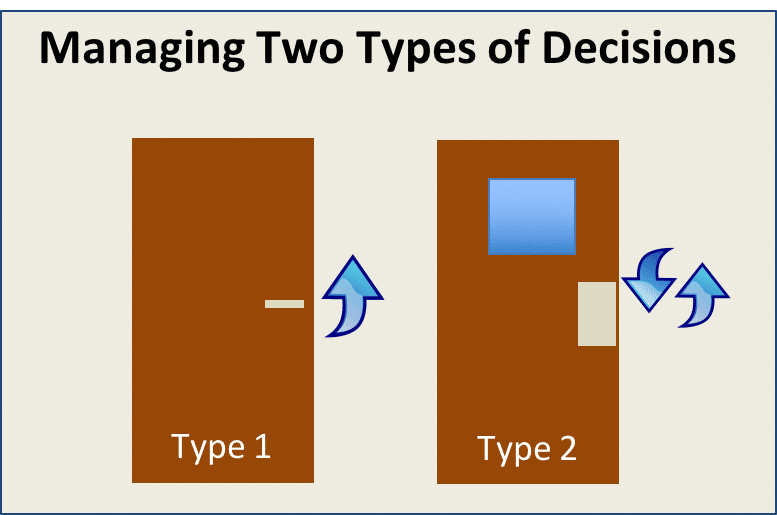
The main point about Type 1 vs. Type 2 decisions is that you shouldn’t treat all decisions the same way. A Type 1 decision is a big, strategic decision that it’s hard to turn back from. It’s like a one-way door without a window. It’s hard to predict what happens on the other side of the door and you can’t go back once you’ve crossed the threshold. A Type 2 decision, on the other hand, is an everyday operating decision. It’s like a regular two-way door with a window. You can look through the window and see what’s happening on the other side. And if it turns out that it was a bad decision, the consequences aren’t disastrous. You can go back pretty easily and correct it.
I like the two door metaphor a lot. The concept of “stepping over the threshold” helps to create shared organizational consciousness for how to treat different classes of decisions differently. However, I often hear Leadership Teams express some hesitation when considering adopting the 3 Agreements as operating agreements. They are concerned about whether their own culture can really tell the difference between a Type 1 and Type 2 decision. They fear that too many Type 1 decisions will be treated as Type 2s and things will spin out of control, or that they’ll get bogged down processing too many Type 2s.
There will naturally be questions as to what’s really a Type 1 vs. a Type 2 decision in your own company. The answer depends on the level of autonomy and leadership style of the CEO who is the ultimate arbiter of what is a Type-1 or Type 2 decisions. I.e., what is a Type-1 decisions for one company could be a Type-2 decision for another. Wherever your business stands on this spectrum, it’s critical to teach your culture to ask and clarify upfront, “Is this a Type-1 or Type-2 decision?” Then treat it accordingly.
It is also an imperative that every action assigned in your Leadership Team Action Plan is identified upfront as either a Type 1 (meaning it needs to come back to the Leadership Team as a formal proposal) or a Type 2 (meaning that it doesn’t need to come back as a proposal but the owner still needs to seek perspective). Again, the CEO is always the arbiter of what’s a Type 1 or Type 2. And when in doubt, ask.
One other comment here. It’s common in the first few months of adopting the 3 Agreementss that a Leadership Team will want to treat what are really Type 2 decisions as Type 1s. It’s OK. But as the confidence level increases, the CEO needs to become more vigilant about making sure that the Leadership Team only spends its time and effort on the most strategic and important proposals for the business — true Type 1 decisions — not on Type 2 decisions that aren’t worth the time and effort to process at that level.
Won’t This Slow Us Down?
 One objection I frequently hear is that taking the time to seek perspective from others before making a decision will slow the company down. On the contrary, if done correctly, this should increase overall execution speed significantly.
One objection I frequently hear is that taking the time to seek perspective from others before making a decision will slow the company down. On the contrary, if done correctly, this should increase overall execution speed significantly.
I think this objection comes from too many leaders and management gurus still holding the erroneous belief that “high-velocity decision making” is the same thing as “high-velocity execution.” I.e., see President Trump in his first 9 months of office issuing a stream of executive “orders” but then usually failing to implement those policies in a swift and coherent way. Obviously, the real secret to building and sustaining momentum in a business is not only to make good decisions but also to implement them fast, and repeat.
The irony is that the act of seeking perspective, while certainly taking more time up front, actually leads to better decision making (because you get more perspectives on a problem and how to best solve it) and faster implementation (because you’ve lowered the resistance to change by involving in the decision making process those who will be impacted downstream). In Organizational Physics, we call this “gathering the mass.” If you’d like to understand this concept further, start with The Physics of Fast Execution.
Do I Really Have to Make Type 1 Proposals in Writing?
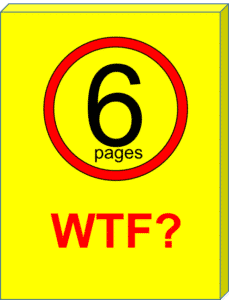 You may have noticed that most of the media attention surrounding the Type 1 decision making topic has focused on the almost mythical “6-page narrative” as Amazon’s secret sauce for Type 1 decisions. Why exactly six pages and what is it about the number six? Getting hung up on the number of pages in a proposal confuses quantity with quality. It’s also a good example of mistaking policy for principle.
You may have noticed that most of the media attention surrounding the Type 1 decision making topic has focused on the almost mythical “6-page narrative” as Amazon’s secret sauce for Type 1 decisions. Why exactly six pages and what is it about the number six? Getting hung up on the number of pages in a proposal confuses quantity with quality. It’s also a good example of mistaking policy for principle.
That said, I strongly agree that Type 1 proposals should be written out. Writing out a Type 1 proposal in full sentences, with the right level of detail, is a great forcing function. It requires the proposer to really think things through. It reveals errors in logic and helps to identify the right solution in detail. It also spares you those bad PowerPoint presentations. Awesome.
But no, six pages is not some magical number to get your idea across. Ideally, it shouldn’t take that many pages to get your point across, especially if you’ve relegated the appropriate amount of data to the appendix. By the way, if you’re interested in a good proposal-making template to share with your team, you can download my Type 1 Proposal Template here. It’s a one-page outline that you can use to build your up-to-6-page Type 1 decision-making proposals and that works very well for most situations.
Don’t We Risk Having Unqualified People Make Decisions?
 Yes and no. The biggest and most important idea behind the Type 1 vs. Type 2 decision-making process is that there’s a clearly defined, single decision-making body and decision-making process for major, Type 1 decisions! (This is actually the overlooked but brilliant part of enabling high-velocity decision making and execution, not the aforementioned six-page proposal).
Yes and no. The biggest and most important idea behind the Type 1 vs. Type 2 decision-making process is that there’s a clearly defined, single decision-making body and decision-making process for major, Type 1 decisions! (This is actually the overlooked but brilliant part of enabling high-velocity decision making and execution, not the aforementioned six-page proposal).
Think for a moment about how confusing it is for employees to know where to go and how to process a major, significant decision in most organizations. The sad fact is that many people in a company can feel empowered to say “no” to an idea even if they’re not accountable for the implementation or they don’t even fully understand it. For an employee to take the ball and drive a new initiative forward requires a lot of time and energy, and often involves dealing with confusion, uncertainty, and rejection.
At the same time, as the CEO, you can’t allow everyone to run around half-cocked, pursuing major new strategic initiatives that might be misaligned with the company’s core strategy. The everyday work obviously has to get accomplished too.
But now, with Agreement #1 in place, there’s a well-defined team (the Leadership Team) and a regular and consistent process (the Leadership Team meeting) for making strategic, Type 1 decisions. This can be transformative by improving organizational velocity. Someone in accounting doesn’t like your idea? Too bad for them. Get your Type 1 proposal on the upcoming Leadership Team meeting agenda and make your case for why your idea is a great one, with the data to back it up. If the process is run correctly, there won’t be any confusion between a decision that has actually been made and an idea that is still in discussion. Decisions are documented and everyone is clear about the status of a proposal in this process. Clarity brings power and velocity.
However, this also means that you are allowing individuals to take the ball and run on lower risk, everyday, Type 2 decisions. Will people make mistakes? Absolutely. Will there be priceless learning opportunities for these staff members? Absolutely. Are you willing to give up control of these less critical decisions and accept the trade-offs? That’s the real question that only you can answer.
Do I Always Have to Seek Perspective?
 Do you always have to seek perspective? No! Here’s the acid test: Is anyone else impacted upstream or downstream by your decision? If not, then no, don’t seek perspective. Just get it done. But if others are materially impacted, you’ll find that seeking perspective makes your life a lot easier. Not only does it lead to a better decision, it also reduces flak on implementation.
Do you always have to seek perspective? No! Here’s the acid test: Is anyone else impacted upstream or downstream by your decision? If not, then no, don’t seek perspective. Just get it done. But if others are materially impacted, you’ll find that seeking perspective makes your life a lot easier. Not only does it lead to a better decision, it also reduces flak on implementation.
Knowing who to seek perspective from on any given initiative comes with organizational experience. If you’re unsure, ask a more seasoned player, “Who else should I seek perspective from?” and that will usually guide you in the right direction.
There’s also a technical answer to this question: You must seek perspective (gather the mass) from the minimum number of people with authority, power, and influence over the implementation. (Authority, power, and influence are valuable concepts to understand but they are beyond the scope of this article. You can learn more about them in Mastering Team Based Decision Making).
How Can I Tell if I’ve Adequately Gathered Perspective?
 In a word, pay attention to the level of “flak” during implementation. Flak is a term coined by British bomber crews during WWII. Back then, if you were taking flak from enemy fire, you were usually in a bad situation and your plane could go down in flames at any moment.
In a word, pay attention to the level of “flak” during implementation. Flak is a term coined by British bomber crews during WWII. Back then, if you were taking flak from enemy fire, you were usually in a bad situation and your plane could go down in flames at any moment.
Organizational flak is similar. You’ve made what you thought was a good decision but now you’re in implementation mode and, rather than things being fast and easy, you’re getting a lot of criticisms, doubts and resistance from the people and teams impacted by it. As a rule of thumb, anytime you’re taking flak, it’s a sign that you haven’t done a good enough job of gathering the mass up front. Low flak and fast implementation means that you’ve done a good job of gathering the mass up front.
Who Is the Implementer and Why Do They Get To Decide?
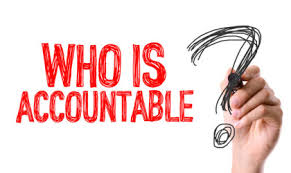 I want to be very clear that I am not promoting democracy as a method to make and execute decisions in your company. The goal is an organizational culture built on team participation and an active debate of ideas, but with one role accountable for the decision! In most instances, the role accepting the decision should be the role that also has to own the implementation.
I want to be very clear that I am not promoting democracy as a method to make and execute decisions in your company. The goal is an organizational culture built on team participation and an active debate of ideas, but with one role accountable for the decision! In most instances, the role accepting the decision should be the role that also has to own the implementation.
Think about it. Would you rather be told what to do or participate in deciding what to do? This is why Agreement #1 says that the proposal must be “accepted by the implementer.” This is also why it’s so critical to push authority as far as possible down to the appropriate level in the structure.
What if Someone Violates an Agreement?
 Earlier I mentioned that anyone who makes a habit of violating the agreements “shall be dismissed.” This means that if someone consistently fails to adequately seek perspective when driving new initiatives forward, they get fired.
Earlier I mentioned that anyone who makes a habit of violating the agreements “shall be dismissed.” This means that if someone consistently fails to adequately seek perspective when driving new initiatives forward, they get fired.
Remember that if principles aren’t backed by real consequences, they’re not real operating principles; they’re just platitudes.
Why Only Three?
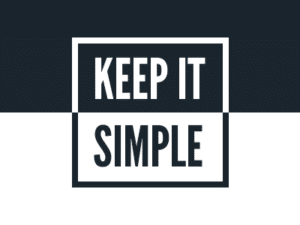 It’s pretty common for highly innovative organizations to like the spirit behind the 3 Agreements and then immediately want to expand them to four or five or more. I recommend that you start with three and master those as an organization before considering expanding them. Remember too that the intention of the 3 Agreements is not to replace your core values, strategic plan, OKRs, or other methods that you are using to create alignment. If they are effective, those things should stay and continue to be reinforced. The 3 Agreements are only focused on how to make decisions and take initiative.
It’s pretty common for highly innovative organizations to like the spirit behind the 3 Agreements and then immediately want to expand them to four or five or more. I recommend that you start with three and master those as an organization before considering expanding them. Remember too that the intention of the 3 Agreements is not to replace your core values, strategic plan, OKRs, or other methods that you are using to create alignment. If they are effective, those things should stay and continue to be reinforced. The 3 Agreements are only focused on how to make decisions and take initiative.
Where Do We Start?
Anytime you’re considering making a big organization-wide commitment like adopting a set of operating agreements, start at the top. This means that the 3 Agreements must first come alive with your Leadership Team before attempting to cascade them throughout your entire organization. If you build commitment first at the head, the body will usually follow. Besides, testing it out with a smaller group allows you to Pilot it and Nail it before Scaling it.
In my experience, it usually takes about two quarters of piloting the 3 Agreements with your senior leadership team before you can commence a broader organizational roll-out. You should actually treat adopting the 3 Agreements as your Leadership Team’s first Type 1 proposal.
Creating Organization-Wide Alignment
 Obviously, adopting any set of operating agreements isn’t going to radically change the behavior of your organization in isolation. It’s like painting your house. If the house has a bad design or is in need of renovations, painting isn’t going to improve your living conditions very much. But if it’s a well-designed house and in good condition, the right coat of paint is going to bring everything together quite nicely.
Obviously, adopting any set of operating agreements isn’t going to radically change the behavior of your organization in isolation. It’s like painting your house. If the house has a bad design or is in need of renovations, painting isn’t going to improve your living conditions very much. But if it’s a well-designed house and in good condition, the right coat of paint is going to bring everything together quite nicely.
It’s the same for these agreements. You’ve got to have some prerequisites for organizational alignment already in place before they will make a big difference. Some of the most important areas where you’ll want to create alignment are Strategy, Culture, Structure, Process, and People. If you do have these basics for organizational alignment in place, then you should find that the 3 Agreements will help you catalyze the right organizational behaviors and tie everything together.
Not only do these principles enable Bezos to lead Amazon to innovate and disrupt multiple-billion dollar industries simultaneously; in my coaching practice, I have seen them first-hand help dozens of next-generation companies (typically $10M-$300M in baseline revenue) to realize a 2-3x increase in sales while simultaneously improving operational efficiency and coordination by 65-75% – all without compromising their core values.
If you need help getting organization-wide alignment with these prerequisites, you might want to check out my Strategic Execution Coaching Program and my Organizational Design Program.
Summary
If you want to scale your business successfully — without sacrificing innovation, core values, or execution speed as things get more complex — you’ll need to design on principles, not policies. To help you do this, I’ve provided you with a couple of highly effective one-page templates about Type-1 and Type-2 decision making that you can use. I hope you find them helpful. However, make sure that you have the basics for organizational alignment in place before attempting to adopt them, otherwise you will expend a lot of effort for minimal results. It should also be clear that adopting principles is only as effective as the leader’s commitment to implementing and reinforcing them.
Onward, upward!




